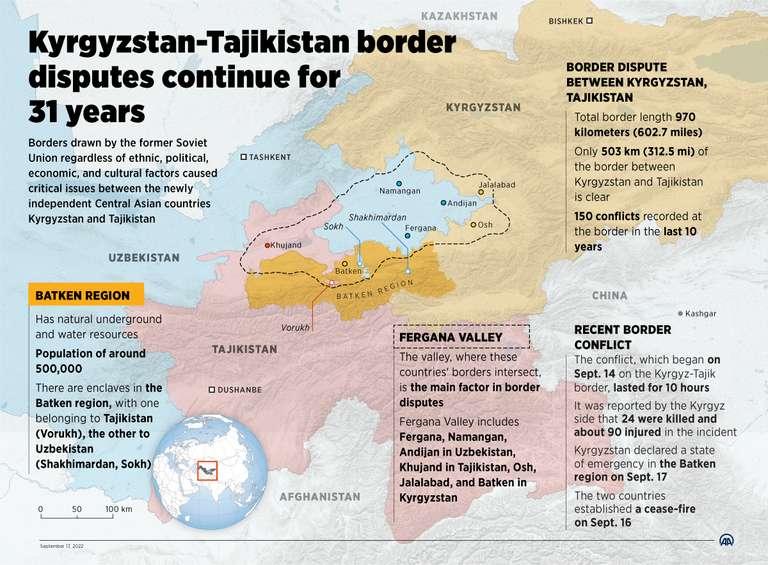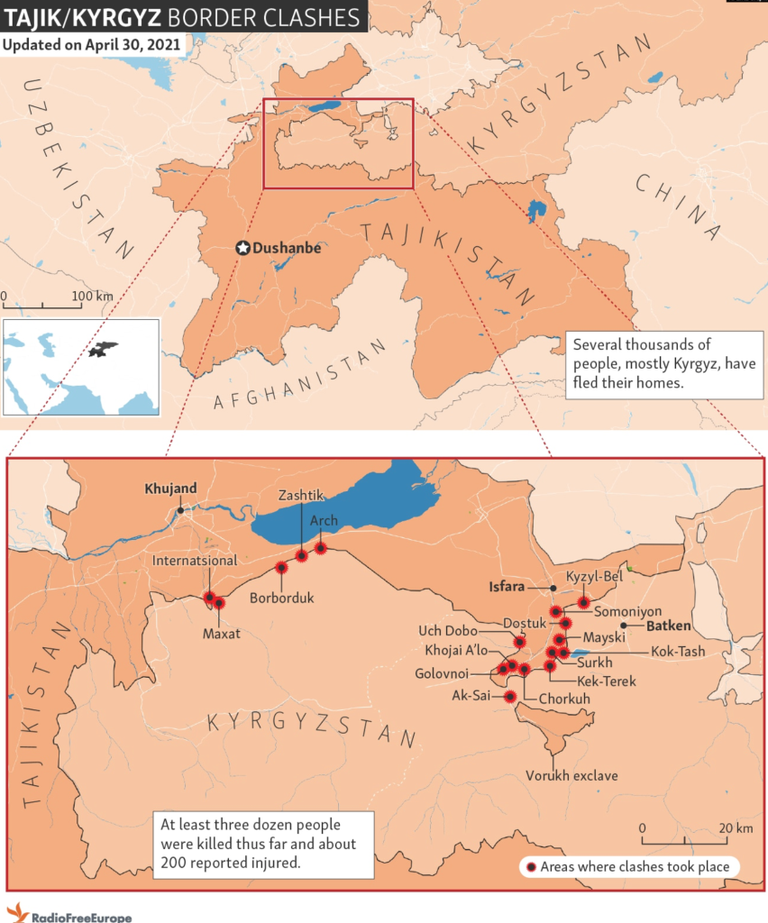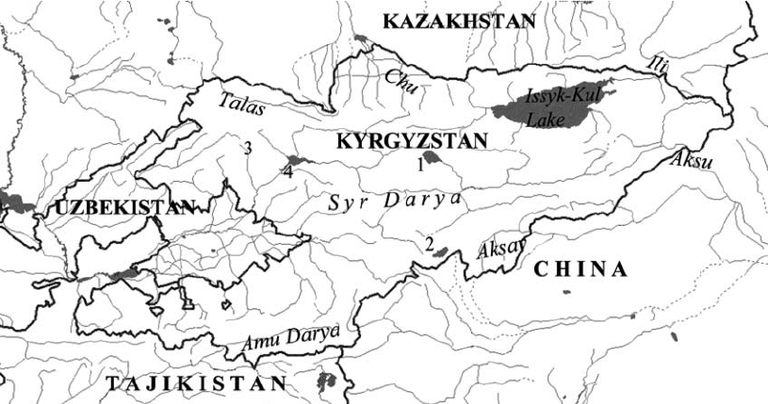
A year ago, Tajikistan and Kyrgyzstan fought a brief but bloody war over their disputed border. While the violence has since subsided, the two countries are now engaged in a sort of arms race, with Tajikistan supported by Iran and Kyrgyzstan supported by Turkey. And earlier this month, the head of Kyrgyzstan security services warned that unless Tajikistan gave up its territorial claims, Kyrgyzstan would quote, advance our own claims and that they have both the strength and the ability to reclaim lands handed over to Tajikistan hundreds of years ago. So in this article, we're going to have a look at the two countries ongoing border disputes. Why water shortages and Russia's withdrawal as a regional security guarantor have exacerbated tensions, and what might happen next.
So let's start by explaining why Tajikistan and Kyrgyzstan don't get on. Essentially, both countries used to be part of the Soviet Union, but when the Soviet Union collapsed in 1991, they were unable to agree on a new border. The border is about 1000km long, running from the tri point with Uzbekistan to the tri point with China, but they've been unable to agree on the precise demarcations of roughly a third of it. The contested areas are basically in the northwest of Tajikistan, where Tajikistan essentially surrounds Kyrgyzstan, creating a sort of semi-circular border, and the two countries can't agree on how precisely to demarcate the top half of the semicircle. Another reason the current border doesn't really work is because Tajikistan has two enclaves in Kyrgyzstan, Vorukh the larger one which is a sort of suburb of the city of Isfara and has a population of about 45,000, and Lolazor or the smaller one to the west, which basically just includes the small town of Kayragach and has a total population of about 3000 people. Unsurprisingly, these enclaves have been a point of tension in the past. In 2013, fighting broke out between Vorukh residents and Kyrgyzstan labourers over plans to build a new road that would bypass the enclave, and in 2019 there were multiple casualties when Kyrgyzstan residents shot at Tajikistan residents after they installed Tajikistan national flags over the road to Vorukh.

For context, these enclaves were created by the Soviet Union in the 1920s, when the Soviets were hurriedly trying to draw borders that mapped onto the population distribution of what the Soviets saw as the three main ethnic groups Kazakhs, Turkmen and Uzbeks. As we're finding out in Ukraine and Armenia. It turns out the Soviets weren't very good at drawing borders, or at least drawing borders that would survive the Soviet Union's dissolution. And lots of the other borders in Central Asia are similarly messy, Uzbekistan also has four enclaves in Kyrgyzstan and both Tajikistan and Kyrgyzstan have one enclave each in Uzbekistan, which have been the source of some dispute in the past. Anyway, back to Tajikistan and Kyrgyzstan. The two countries have engaged in numerous border skirmishes over the years, but tensions have really escalated in the past few years. Previously, border conflicts had rarely resulted in significant casualties, but in April 2021, there was a three day war that killed at least 50 people, and in September 2022, there was another war that killed as many as 200 people. For the first time, tanks, armoured personnel carriers and drones were used in the fighting and over 130,000 people had to be evacuated. The fighting died down after about a week, but tensions are still running high and both sides have been investing heavily in their militaries recently, which suggests they're gearing up for another round of fighting sometime soon.
So what's going on here? Why have tensions escalated recently? Well, as I see it, there were two main reasons. The first is water. Central Asia has always had limited water, but climate change, chronic mismanagement and increasing demand have made things significantly worse. Recently, the Syr Darya river, one of the biggest and most important rivers in the region, runs along the northern part of the contested border, and one of its distributor, the Isfara River, literally runs across the border down towards Faruq. The contested region contains critical chokepoints along rivers that provide water to Kyrgyzstan's district capital city and to large swathes of irrigated farmland into Tajikistan. Many of the recent border skirmishes have been triggered by arguments about who gets to control the water, the violence in 2021 for example was caused by a disagreement over who controls the Golovny water distribution station, which lies on the ice Isfara River. As regional anxieties about water have become more acute, tensions have escalated and we've seen a corresponding uptick in violence. The other reason for the escalation is Russia, and specifically the fact that it can no longer play the role of a regional security guarantor.

Previously, Russia was basically able to keep the peace between these two countries, in part because they were both members of the Russian led Collective Security Treaty Organization, usually referred to as the CSTO. While it's unclear whether a border conflict between two members of the organization would require an intervention by Russia, the ambiguity and Russia's regional dominance were enough to keep things in check. However, because Russia is tied up in Ukraine, it can no longer act as a security guarantor, which has destabilized the region. We've seen something similar in Armenia, which is also a CSTO member where Russia's withdrawal has encouraged Azerbaijan into more aggressive action on Nagorno-Karabakh. With Russia out of the picture, other regional powers have stepped in, stoking tensions and turning the conflict into a sort of proxy war. Broadly speaking, Tajikistan is supported by Iran, while Kyrgyzstan is supported by Turkey. Again, this similarities here with what's happening in the caucuses, where Armenia is supported by Iran and Azerbaijan by Turkey, and both Turkey and Iran have recently built factories in Kyrgyzstan and Tajikistan to produce Bayraktar and Shahid drones.
So you get the idea. As Russia has withdrawn, other regional powers with more partisan sympathies have stepped in, further destabilizing the region in the future, it'll be interesting to see whether China, which has been slowly replacing Russia as the preeminent regional superpower, or America which has taken a renewed interest in the region via the new C5+1 dialogue, can replace Russia as a security guarantor and neutral mediator in future conflicts. As a final thing, in some sense, these tensions can be understood as deferred violence from the collapse of the Soviet Union. The collapse of the Soviet Union was astonishingly peaceful. It's almost historically unprecedented for such a large state to collapse with such little violence, especially given that it was one of two superpowers in a bipolar world order. In some sense what we're seeing in not just Central Asia, but also Armenia and Ukraine is a delayed after effect of the Soviet Union's dissolution. Now, to be clear, that's not to deny that there were other, more proximate causes and explanations for these conflicts, but it's noteworthy that so many of the world's current geopolitical tensions are in former Soviet states.
Source of potential text plagiarism
Plagiarism is the copying & pasting of others' work without giving credit to the original author or artist. Plagiarized posts are considered fraud. Fraud is discouraged by the community.
Guide: Why and How People Abuse and Plagiarise
If you believe this comment is in error, please contact us in #appeals in Discord.